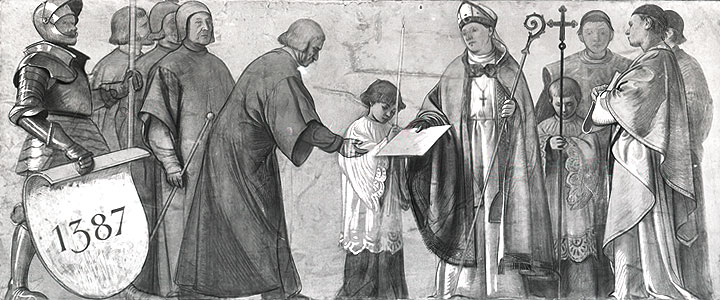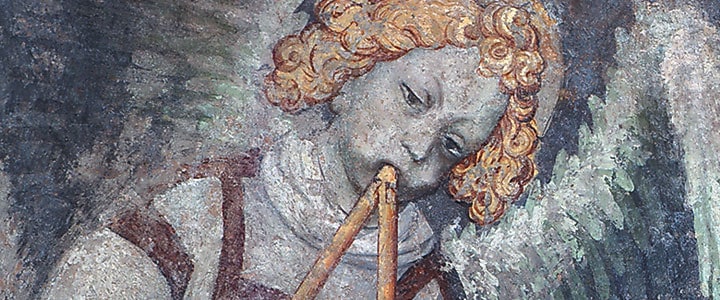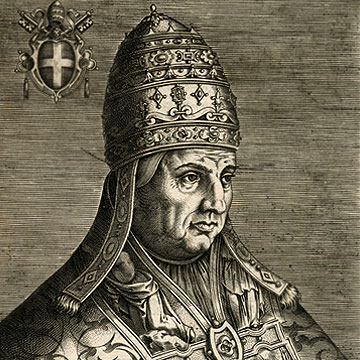St-Peter in the Middle Ages
The construction of the new cathedral
In 1032, Geneva was incorporated into the Germanic Holy Roman Empire, of which it now constituted an episcopal principality (hence the presence of the demi-eagle and key in its heraldic insignia). Emperor Conrad the Salian was crowned King of Burgundy at St Peter’s Cathedral in 1034. In the Middle Ages, in Geneva and in Europe as a whole, the Catholic Church had a monopoly on religion and maintained strict control over politics. The 11th century was marked by the intense Christian fervour that accompanied the Crusades. Geneva was part of this too. From the year 1158 onwards, all the townspeople got firmly behind, and played a role in, the construction of the new cathedral, a project that was driven through by the prince-bishop of Geneva, Arducius de Faucigny. The set of buildings was completed in 1288, but was to be constantly renovated and redesigned thereafter, in large part due to a series of fires.
The Franchises of Adhémar Fabri
The completion of this edifice, which is at the origin of the cathedral as we know it today, coincides with another event that was significant for the people of Geneva. Although they were subjects of the emperor, the bishop and the count of Geneva (who were constantly bickering amongst themselves), the citizens of Geneva wanted to acquire a certain amount of independence, and have a municipal body. In 1288, they founded the brotherhood of St Peter and took over control of the cathedral, which became their fortress. This was the first time that the cathedral had come under a ‘secular’ occupation. They were driven out of it by the Count of Geneva in 1291 (with the bishop’s consent). In 1309, thanks to the support of the Count of Savoy, the people of Geneva secured an acknowledgement on the part of the bishop that the commune legally existed. But almost a century would go by before they were to officially have the degree of autonomy they enjoyed in reality, in the form of the Franchises granted to St Peter on 23 May 1387 by Bishop Adhémar Fabri, who was surrounded by eminent members of the Chapter of the cathedral when this took place.

The 14th century brought its fair share of calamities to Geneva and its cathedral. Even as the first plague epidemics were decimating Europe, a series of fires ravaged St Peter’s. At the end of the century, major restoration work was required at the cathedral.
The functions of St Peter in the late Middle Ages
St Peter served as the beating heart of the city. It was here, of course, that the General Council, the citizens’ plenary assembly, met at the start of each year to elect the four syndicates that would form the government of Geneva. Up until the Reformation, the cathedral and the cloisters were used for burials. The position of the grave is determined based on the deceased’s social status, and must be paid for. But St Peter also played host to big ceremonies - both festive ones and solemn ones. In 1365, Emperor Charles IV, who had moved to Avignon - the new Rome - was received their with much munificence.
The Chapel of the Maccabees

The start of the 15th century saw St Peter acquiring the Chapel of the Maccabees, built in 1406 by the Cardinal of Brogny to house his tomb and those of his family. The name is doubtless a reference to the seven Hebrew martyrs. It is not known whether it may have housed a relic.
Clemency
Another important acquisition arrived at St Peter’s in 1407: the huge bell dubbed La Clémence (Clemency) by the man who donated it, Guillaume de Lornay, in homage to the ‘anti-pope’ Clement VII (of Avignon), who appointed him Bishop of Geneva. The bell was installed in the north tower and went on to play a major role in the religious and political history of Geneva. It calls people to prayer, praises God, protects the city and chases away demons; it calls on the citizens to submit to religion, but it also summons them to meetings of the General Council, which brings all the citizens to the cloisters to elect the magistrates.
In 1430 fire broke out at the cathedral again, this time causing damage to the south tower and destroying the spire. The spire was replaced by an iron bell-tower that was to remain in place until the current spire was built, during the major restoration work that took place in 1898.
In 1441, the north wall of the nave collapsed, crushing the chapter house that overhangs the cloisters and a large part of the cloisters themselves, and causing the vaulted ceiling of the nave to come crashing down too. Major restoration work took place thereafter.
The threat from Savoy

For Geneva, the early 15th century was also marked by the threat that came from the rulers of Savoy, who had once been friends of the city. Duke Amadeus VIII tried to persuade the Pope to grant him sovereignty over Geneva. In 1440, he was named antipope under the name of Felix V. In 1449 he submitted himself to the authority of Nicholas V, thereby ending the Western Schism, and was appointed Bishop of Geneva. Thenceforward, he defended the city’s Franciscans and supported the restoration work on the cathedral, which had still not been restored since the last fire.
At the start of the 16th century, the south tower was adorned with opulent decorations, in what constitutes a late example of the flamboyant Gothic style. Finally liberated from outrages past, St Peter was now going to experience the stormy period of the Reformation.